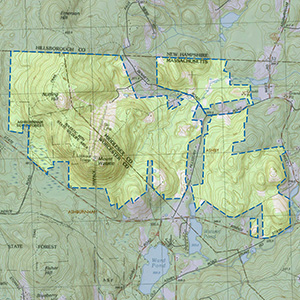Important Bird Area Sites in Massachusetts
Important Bird Area: Mt. Watatic
Site Summary
Nominated By
Paul Roberts
Size
1,536 acres
Towns and Counties
Ashburnham, Ashby; Middlesex, Worcester
Ownership
Department of Conservation and Recreation, MassWildlife, Asbhy Land Trust, Ashburnham Conservation Trust
Major Habitats
10% spruce-fir forest, 40% northern hardwood forest, 50% oak-conifer forest, emergent freshwater wetland, lake/pond, river/stream
Land Use
nature & wildlife conservation/land trust, hunting/fishing, other recreation or tourism, forestry, water supply, undeveloped
Serious Threats
deforestation, water & air pollution, excessive soil erosion/degradation, habitat conversion, residential/commercial development, cellular towers, disturbance to birds or habitat, recreational development/overuse, hydrologic changes
IBA Criteria
- Category 1: Sites important for long-term research and/or monitoring projects that contribute substantially to ornithology, bird conservation, and/or education.
- Category 4: Sites containing assemblages of species characteristic of a representative, rare, threatened, or unique habitat within the state or region.
- Category 5: Raptors: The site is a bottleneck or migration corridor for more than 5,000 migratory raptors during a migration season.
Site Description
Mount Watatic, elevation 1,832 feet extending is part of an archipelago of summits called the Wapack Range rising out of the Worcester Plateau and extending into southern New Hampshire. Mount Watatic shares geologic and vegetative characteristics similar to those on both Mount Wachusett, 17 miles to the south, and Pack Monadnock, 12 miles to the north. Mount Watatic and the other peaks of the archipelago are part of a range of mountains consisting of crystalline rocks that extend from Connecticut through central Massachusetts and on into southern New Hampshire & Maine. With its spruce-covered summit, the mountain is home to many Northern bird species, including the Olive-sided Flycatcher, Winter Wren, Ruby-crowned Kinglet, and Magnolia Warbler. Other breeding species include the Sharp-shinned Hawk, Red-shouldered Hawk, Ruby-throated Hummingbird, Yellow-bellied Sapsucker, and White-throated Sparrow. During September thermals and updrafts off the summit often attract unusually large numbers of migrating Broad-winged Hawks. Over 14,000 of this species were reported each September in 2000 and 2001. As the southern terminus of the Wapack Range, it also attracts many of the late-season, ridge-flying migrants, including the Sharp-shinned and Cooper's Hawk, Northern Goshawk, and Red-shouldered Hawk, as well as impressive numbers of Bald and Golden Eagles.
Current Conservation Status
Mount Watatic is a jewel among Massachusetts' natural resources. Reactions to threats posed by the development proposed by a communications company may result in successful efforts to preserve the mountain in an essentially natural state and as a suitable site from which to continue hawk migration research. A significant portion of the understory on the western slopes along the Wapack Trail has been removed by people making fires on the mountain. Friends of the Wapack (FOW) has discouraged camping and fire making on the mountain. Siltation has been a problem on the eastern slopes of the mountain. The cause was four-wheel-drive vehicles being used on the old ski slopes and causing erosion. A couple of heavy-duty gates have been installed on the property. The top of the mountain is threatened by erection of a cell tower and a building at the base of the tower. Furthermore, the company that will be building the tower facility has submitted plans for a subdivision at the eastern base of the mountain. A road to the summit was built in 2000, but the tower has not yet been constructed as of this writing due to widespread opposition, manifested in the form of many lawsuits. On June 6, 2002, it was announced that the Massachusetts Department of Conservation and Recreation had signed a purchase-and-sale agreement to acquire the approximately 300 acres of Watatic owned by the communications company.
Ornithological Significance
Mount Watatic is one of the premier hawk migration and observation sites in the Northeast. The summit was first used as a fall hawk migration count site in 1977 by Paul and Julie Roberts, on behalf of the Eastern Massachusetts Hawk Watch (EMHW), the NorthEast Hawk Watch (NEHW), and the Hawk Migration Association of North America (HMANA). Consistent fall hawk migration coverage was established in 1988. Hawk watchers have recorded an average of 13,231 hawks annually each fall over the past five years, averaging 258 hours of observation during that period. An average of 8,368 hawks have been recorded each fall since 1988, during an average 161 hours of observation. The spring hawk migration is believed to be considerably smaller than the fall migration and has been documented only intermittently over the past 24 years. The summit of the mountain provides an excellent location to view other migrants, including Canada and Snow Geese, Herring and Ring-billed Gulls, Common Ravens, Ruby-throated Hummingbirds and other waterfowl, warblers, and winter finches.
Data Sources
Data reported since 1987 by Tom McCullough and, more recently, Petti Staub. Observations published bimonthly, or on a seasonal or annual basis as noted below.
Eastern Massachusetts Hawk Watch, Fall Report, published annually since 1977
Hawk Migration Association of North America, HMANA Hawk Migration Studies, published semiannually beginning in September 1988
NorthEast Hawk Watch, NorthEast Hawk Watch Report, published annually since 1977
Bird Observer, "Bird Sightings," published bimonthly since 1977
Zalles, J. I., and Bildstein, K.L., eds (2000) Raptor Watch: a global directory of raptor migration sites. Cambridge, UK: BirdLife International; and Kempton, PA, USA: Hawk Mountain Sanctuary (BirdLife Conservation Series No. 9) Eastern Massachusetts Hawk Watch, Spring Report, published annually since 1977




